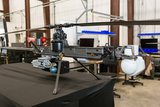NATO needs to plug its drone gap to meet modern warfare requirements
The Sentinel CUAS system has been proposed as a frontline solution. (Image: Alpine Eagle Defence Ltd)
A report by German Alpine Eagle Defence Ltd (AEDL) – a company that claims to be the developer of the world’s first airborne counter-drone system – has raised concerns over NATO’s eastern flank posture, noting current systems are inadequate to counter the pace of modern drone warfare.
The October white paper, Building Counter-UAS into NATO’s Eastern Shield, highlights persistent radar blind spots and cost asymmetries that risk undermining alliance deterrence along its eastern flank. It documents a series of Russian drone incursions that prompted temporary airport closures in Warsaw, Lublin and Rzeszów in Poland.
AEDL’s report positions airborne radar not as a replacement
Already have an account? Log in
Want to keep reading this article?
More from Air Warfare
-
![Anduril UK and GKN Aerospace collaborate on British Army ACP bid]()
Anduril UK and GKN Aerospace collaborate on British Army ACP bid
The pair will submit their demonstrator concept for Project Nyx, a development project for the British Army’s Land Autonomous Collaborative Platform.
-
![US Army command’s Picatinny CLIK common lethal drone interface makes progress]()
US Army command’s Picatinny CLIK common lethal drone interface makes progress
The Picatinny Common Lethality Integration Kit is designed to overcome the issue of unique integration methods between lethal payloads and drones as well as avoiding problematic acquisition conditions created by vendor lock.
-
![Australia invests extra A$1.4 billion in MQ-28A Ghost Bat after successful missile fire test]()
Australia invests extra A$1.4 billion in MQ-28A Ghost Bat after successful missile fire test
The investment includes new contracts for six MQ-28A Ghost Bat aircraft, as well as provisional funds to invest in the development of a Block 3 prototype.
-
![US approves potential $4.7 billion missile and air defence system sales to Denmark and Italy]()
US approves potential $4.7 billion missile and air defence system sales to Denmark and Italy
Italy could field the JASSM-ER for its combat aircraft including the F-35, while Denmark has been approved for AMRAAM and an Integrated Battle Command system procurement.
-
![Northrop Grumman to fly new Project Talon CCA by late 2026]()
Northrop Grumman to fly new Project Talon CCA by late 2026
The newly unveiled collaborative combat aircraft looks to strike a balance between capability and cost-effectiveness, according to the company.
-
![MBDA and Lockheed move closer to F-35A Meteor flight tests]()
MBDA and Lockheed move closer to F-35A Meteor flight tests
Following the completion of successful ground tests, one more exercise remains before flight testing can begin.























